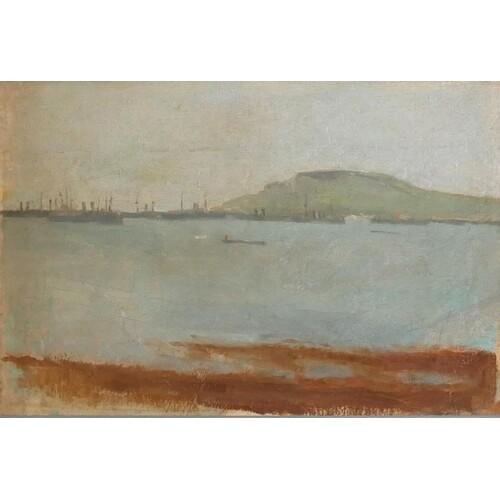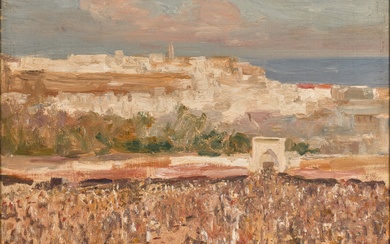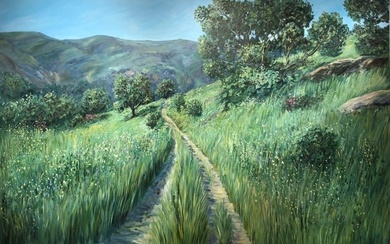SIR JOHN LAVERY, R.A. R.S.A., R.H.A., 1856 - 1941, OIL ON CA...
SIR JOHN LAVERY, R.A. R.S.A., R.H.A., 1856 - 1941, OIL ON CANVAS, CIRCA 1917/18
Battleships at anchor.
(sight 25.3cm x 37.5cm, frame 34cm x 46.5cm)
N.B. John Lavery was one of the most prolific and hard working Official War Artists of the First World War, yet this aspect of his career is relatively little known or appreciated. What Lavery did so well was produce the first picture of Britain's naval and air defences'.
In a letter to the present owner in Aug 2019, Angela Weight, former Keeper of Paintings at IWM 1981 - 2005, and Lavery curator, adds:
'Lavery was not a precise topographical painter and was not interested in the particularities of naval ships: in his seascapes they are just brushed in and are not identifiable as British, German or American by the painting alone. The ships in this painting are not in convoy ' they are too close together, not in formation and too close to land. They are in fact at anchor.
The location of this oil sketch could be somewhere around the British Naval Base at Long Hope on the island of Hoy in the Orkney Islands, but it is probably somewhere along the coast of the Firth of Forth, given the overcast greeny-grey sky and absence of snow. Lavery worked around the Firth of Forth in September 1917 and again in the summer of 1918.
Although Lavery was in Scapa Flow for four days from approximately 29th December 1916 to 1st January 1917 (and painted five major paintings, four of which are in the IWM), the German Grand Fleet was not there, as it did not surrender until the end of the War in November 1918. The German Grand Fleet was initially interned at Rosyth in the Firth of Forth after the Armistice. Lavery travelled up from London and was on board Admiral Beatty's flagship HMS Queen Elizabeth on 15 November, awaiting the arrival of the German delegates (The Arrival of the German Delegates, IWM). He witnessed the signing of the surrender document on board HMS Queen Elizabeth on 21 November and his painting The End records this historic moment.
A few days later the German Fleet sailed for Scapa Flow, which was to be its final resting place - the Germans scuttled their fleet on 23 June 1919. However, Lavery was not present to witness either the German Fleet en route to Scapa Flow or when it got there. In conclusion, Battleships at Anchor is the most accurate title for this painting.
I do not doubt that it is by Sir John Lavery.'
* 'John Lavery: An intrepid war artist'. Published in the Burlington Magazine, September 2014. Author: Angela Weight, former Keeper of Paintings at The Imperial War Museum, and curator: Sir John Lavery 'The War at Sea' the inaugural major exhibition to mark the re-opening of the Scottish National Portrait Gallery in 2011.
Condition: the work has been strip lined and conserved to a new stretcher
View it on
Sale price
Estimate
Time, Location
Auction House
SIR JOHN LAVERY, R.A. R.S.A., R.H.A., 1856 - 1941, OIL ON CANVAS, CIRCA 1917/18
Battleships at anchor.
(sight 25.3cm x 37.5cm, frame 34cm x 46.5cm)
N.B. John Lavery was one of the most prolific and hard working Official War Artists of the First World War, yet this aspect of his career is relatively little known or appreciated. What Lavery did so well was produce the first picture of Britain's naval and air defences'.
In a letter to the present owner in Aug 2019, Angela Weight, former Keeper of Paintings at IWM 1981 - 2005, and Lavery curator, adds:
'Lavery was not a precise topographical painter and was not interested in the particularities of naval ships: in his seascapes they are just brushed in and are not identifiable as British, German or American by the painting alone. The ships in this painting are not in convoy ' they are too close together, not in formation and too close to land. They are in fact at anchor.
The location of this oil sketch could be somewhere around the British Naval Base at Long Hope on the island of Hoy in the Orkney Islands, but it is probably somewhere along the coast of the Firth of Forth, given the overcast greeny-grey sky and absence of snow. Lavery worked around the Firth of Forth in September 1917 and again in the summer of 1918.
Although Lavery was in Scapa Flow for four days from approximately 29th December 1916 to 1st January 1917 (and painted five major paintings, four of which are in the IWM), the German Grand Fleet was not there, as it did not surrender until the end of the War in November 1918. The German Grand Fleet was initially interned at Rosyth in the Firth of Forth after the Armistice. Lavery travelled up from London and was on board Admiral Beatty's flagship HMS Queen Elizabeth on 15 November, awaiting the arrival of the German delegates (The Arrival of the German Delegates, IWM). He witnessed the signing of the surrender document on board HMS Queen Elizabeth on 21 November and his painting The End records this historic moment.
A few days later the German Fleet sailed for Scapa Flow, which was to be its final resting place - the Germans scuttled their fleet on 23 June 1919. However, Lavery was not present to witness either the German Fleet en route to Scapa Flow or when it got there. In conclusion, Battleships at Anchor is the most accurate title for this painting.
I do not doubt that it is by Sir John Lavery.'
* 'John Lavery: An intrepid war artist'. Published in the Burlington Magazine, September 2014. Author: Angela Weight, former Keeper of Paintings at The Imperial War Museum, and curator: Sir John Lavery 'The War at Sea' the inaugural major exhibition to mark the re-opening of the Scottish National Portrait Gallery in 2011.
Condition: the work has been strip lined and conserved to a new stretcher





